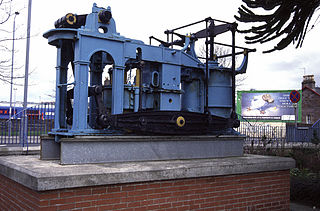
Burrell & Son of Glasgow, Scotland was a leading tramp shipping company. It operated from 1850 to 1939 and was managed by the art collector William Burrell. [1]

Burrell & Son of Glasgow, Scotland was a leading tramp shipping company. It operated from 1850 to 1939 and was managed by the art collector William Burrell. [1]
The firm of Burrell & Son was established around 1850 by George Burrell and initially operated mainly on the Forth & Clyde Canal. The first coastal vessel was acquired in 1862. The first ships were sail, but they quickly moved into steam shipping. (Sir) William Burrell joined his father in the firm in 1876 at the age of 15. His brother George specialised in the technical and engineering side of the business while William specialised in the financial and commercial aspects. The two brothers took over the business when their father died in 1885. [2] [1]
The type of trade they operated was called tramp shipping. Ships did not travel to set destinations at set times, but instead travelled wherever they could get a cargo. Traditionally tramp ships relied heavily on the captains to secure cargoes, so while a ship was unloading cargo in port the captain would try and secure another cargo for another destination. This meant that there were frequent delays and ships might travel only part-full of cargo. William Burrell travelled widely all over the word and established a system of agents who would secure the cargoes prior to the ships arriving in port. This massively increased the efficiency and profitability of the operation. [2] [1]

With the brothers in charge of the company it rapidly expanded both the size and number of ships it operated. William had a great commercial mind and was not afraid of taking risks. In 1894 they bought 17 ships when there was a major depression in the shipping trade. This meant they could acquire the ships very cheaply. When trade picked up a few years later he sold the entire fleet. Between 1900 and 1905 the firm did not own ships but acted as agents and brokers. When the shipping market entered another severe depression he ordered an entire new fleet at rock-bottom prices. Between 1905 and 1911 he acquired a total of 32 new ships, all of a standard design. This made Burrell & Son one of the world's largest and most innovative tramp shipping companies, with nearly 2 per cent of the world's oceangoing tramp ships. Most other tramp ship companies operated 5 or less ships. [2] [1]
Each ship was operated as a single-ship company. Shareholders included prominent Scottish businessmen and Burrell family members, including William Burrell's wife, Constance. A particularly large number of investors were women. [2]
Burrell & Son operated two shipbuilding yards. A small yard on the Forth & Clyde Canal at Hamiltonhill built barges, lighters and small coasters, including the Ina MacTavish . It operated from 1875 to around 1907. A larger yard operated from the Lower Woodyard in Dumbarton from 1881 to 1885. This yard built larger cargo vessels for the Burrell & Son shipping line and for other customers. It closed during a harsh recession in Clyde shipbuilding and never re-opened. [2] [1]
During the First World War, when demand for shipping was intense he again sold virtually the entire fleet, selling the ships for three times what they had cost new. After the war Burrell & Son owned only one ship, the Strathlorne, which they operated until 1930. They continued to act as agents and brokers during this period. There is speculation that they intended to buy again after the war, but the market did not fall as low or as quickly as they had anticipated. When George Burrell died in 1927 Sir William was left on his own, with no son to follow on in business. With art collecting his main priority, the business dwindled and was finally closed down in 1939. [2] [1]

The River Clyde is a river that flows into the Firth of Clyde, in the west of Scotland. It is the ninth-longest river in the United Kingdom, and the third longest in Scotland after the River Tay and the River Spey. It runs through the city of Glasgow. The River Clyde estuary has an upper tidal limit located at the tidal weir next to Glasgow Green.
Sir William Burrell was one of the world's great art collectors. He and his wife Constance, Lady Burrell (1875–1961), created a collection of over 8,000 artworks which they gave to their home city of Glasgow, Scotland, in 1944, in what has been described as 'one of the greatest gifts ever made to any city in the world'. It is displayed at the Burrell Collection museum in Glasgow.

Bowling is a village in West Dunbartonshire, Scotland, with a population of 740 (2015).
William Todd Lithgow was a Scottish ship-designer who became sole owner of an extremely successful shipbuilding company. For much of the 20th century its name was Lithgows, as it was developed further by William's sons Sir James Lithgow (1883–1952) and Henry Lithgow (1886–1948), and then by his grandson Sir William Lithgow. By 1950 it was the largest private shipbuilding company in the world.

William Denny and Brothers Limited, often referred to simply as Denny, was a Scottish shipbuilding company.

Scotts Shipbuilding and Engineering Company Limited, often referred to simply as Scotts, was a Scottish shipbuilding company based in Greenock on the River Clyde. In its time in Greenock, Scotts built over 1,250 ships.
Alexander Stephen and Sons Limited, often referred to simply as Alex Stephens or just Stephens, was a Scottish shipbuilding company based in Linthouse, Glasgow, on the River Clyde and, initially, on the east coast of Scotland.

The Caledonian Steam Packet Company provided a scheduled shipping service, carrying freight and passengers, on the west coast of Scotland. Formed in 1889 to complement the services of the Caledonian Railway, the company expanded by taking over rival ferry companies. In 1973, they were merged with MacBraynes as Caledonian MacBrayne.

The Blyth Shipbuilding & Dry Docks Company Ltd. was a British shipyard located in Blyth, Northumberland, England.

Bartram & Sons was a shipbuilder on Wearside, North East England, that specialised in building cargo ships. It was founded in 1837, taken over in 1968, nationalised in 1977 and closed in 1978.
The Pusey and Jones Corporation was a major shipbuilder and industrial-equipment manufacturer. Based in Wilmington, Delaware, it operated from 1848 to 1959.

Short Brothers Limited was a British shipbuilding company formed in 1850 and based at Pallion, Sunderland since 1869. The company closed in 1964 when it failed to invest to build bigger ships.

David MacBrayne is a limited company owned by the Scottish Government. Formed in 1851 as the private shipping company David Hutcheson & Co. with three partners, David Hutcheson, Alexander Hutcheson and David MacBrayne, it passed in 1878 to David MacBrayne.
SS Ben Robertson was a Liberty ship, Maritime Commission hull number 2432, built during World War II and named for Clemson University alumnus, journalist, and war correspondent Benjamin F. Robertson, who was killed in the crash of a Pan Am Boeing 314 flying boat, the Yankee Clipper, in the Tagus River, near Lisbon, Portugal, on 22 February 1943.

The Clyde Shipping Company was one of the earliest shipping companies in the United Kingdom to provide steamship services.

Anchor Line was a Scottish merchant shipping company that was founded in 1855 and dissolved in 1980.

Messrs Robert Napier and Sons was a famous firm of Clyde shipbuilders and marine engineers at Govan, Glasgow founded by Robert Napier in 1826. It was moved to Govan for more space in 1841. His sons James and John were taken into partnership in 1853.

Robert Duncan and Company was a shipyard in the town of Port Glasgow on the Clyde in Scotland.

Constance Mary Lockhart, Lady Burrell was a Scottish businesswoman, art collector and philanthropist. She was married to Glasgow ship owner and art collector Sir William Burrell. Their collection is displayed at the Burrell Collection museum in Glasgow.